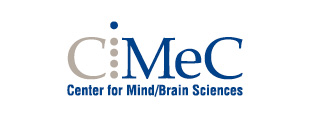Overview
In the Enactive Brain Group, we study the intricate relationship between mind and brain and believe that cognition arises in the interaction of an organism with its environment. We study the relationship between mind and brain primarily in the visual domain where we observe an astonishing discrepancy between our subjective experience of the world and the spatiotemporal dynamics of brain activity.
Clearly, visual perception begins with light stimulating various photoreceptor cells in the retina of our eyes. It is, however, equally clear that the precise activity patterns at the level of the retina have very little to do with what is eventually experienced. For instance, we move our eyes about three to four times per second in a ballistic way with extraordinarily high speed, which renders them some of the fastest movements of the human body. Each eye movement takes tens of milliseconds and defines a period during which the majority of visual input is suppressed; and we are not even aware of these perpetual interruptions.
Obviously, we do not have direct conscious access to what is in front of our eyes. What we eventually experience is instead the result of a cascade of neurophysiological processes that exhibits a myriad of functional principles encompassing attention, learning, memory, adaptation, prediction, and expectation. We try to find out how these principles contribute in concert to conscious visual experience in a naturalistic setting that allows for perpetual eye movements.
Research directions
Current research directions are:
- Where does the natural rhythm of gaze behaviour come from? Natural gaze behaviour exhibits a certain temporal regularity: We make saccadic eye movements about 3-5 times per second. Each saccade is followed by a new fixation period during which the eyes are at relative rest. Interestingly, this temporal order of magnitude resembles an oscillatory frequency in the theta range (3-5 Hz) and theta oscillations have been associated with activity in the hippocampus and memory functions. In this line of research, I try to find out whether and how the natural gaze rhythm is related to memory, using MEG and eye-tracking coregistration in a set of experiments with human participants.
- How is visual input combined across eye movements? Active gaze behaviour implies striking discontinuities in visual input due to the recurring interruptions by saccadic eye-movements. This raises the question of how visual input is combined across successive periods of fixations (trans-saccadic perception). Many researchers have hypothesized that the visual system not only optimally combined input across eye movements but actively predicts upcoming visual information. Using EEG/MEG and eye-tracking coregistration, it is possible to track visual information with respect to dynamic gaze behaviour and investigate whether the spatiotemporal dynamics of neural activity show patterns of predictive processing and predictive coding.
- Do we consciously perceive what was in front of our eyes? Due to neural processing delays, it takes several milliseconds until visual input can be processed to a degree that we are consciously aware of it. There is, however, a debate whether this means that our perception of the world lags behind what is actually happening or whether our brains’ inherent ability to form predictions makes up for this delay and leads to perception at exactly the right time (or even in the future). This issue of a perceptual delay becomes even more apparent considering that we constantly move our eyes at a comparatively high pace. By the time that new visual input from the current fixation is processed to a degree that we can be aware of it, we might already be looking somewhere else. The goal of this project is, thus, to find out whether we are aware of what is or of what was in front of our eyes.
Besides the research directions above, we have a strong interest in methodological developments, statistics and data analysis. Most prominently:
- EEG and MEG methods
- EEG/MEG and eye-tracking coregistration
- Mixed models, hierarchical statistical models
- Bayesian statistics
Members
- Christoph Huber-Huber, Principal Investigator
- Pouriya Hassani, Trainee
- Richard Schweitzer, Research Fellow
Publications
For a complete list see http://christoph.huber-huber.at/publications.html or https://orcid.org/0000-0002-0475-6927
Selected publications:
Huber-Huber, C., Buonocore, A., & Melcher, D. (2021). The extrafoveal preview paradigm as a measure of predictive, active sampling in visual perception. Journal of Vision, 21(7), 12. doi:10.1167/jov.21.7.12
Huber-Huber, C., Steininger, J., Grüner, M., & Ansorge, U. (2021). Psychophysical dual-task setups do not measure pre-saccadic attention but saccade-related strengthening of sensory representations. Psychophysiology, 58(e13787). doi:10.1111/psyp.13787
Huber-Huber, C., & Melcher, D. (2021). The behavioural preview effect with faces is susceptible to statistical regularities: Evidence for predictive processing across the saccade. Scientific Reports, 11(1), 942. doi:10.1038/s41598-020-79957-w
Huber-Huber, C., Buonocore, A., Dimigen, O., Hickey, C., & Melcher, D. (2019). The peripheral preview effect with faces: Combined EEG and eye-tracking suggests multiple stages of trans-saccadic predictive and non-predictive processing. NeuroImage, 200, 344–362. doi:10.1016/j.neuroimage.2019.06.059
Weichselbaum, H., Huber-Huber, C., & Ansorge, U. (2018). Attention capture is temporally stable: Evidence from mixed-model correlations. Cognition, 180, 206–224. doi:10.1016/j.cognition.2018.07.013
Huber-Huber, C., & Ansorge, U. (2017). The role of RT carry-over for congruence sequence effects in masked priming. Journal of Experimental Psychology: Learning, Memory, and Cognition, 43, 757–780. doi:10.1037/xlm0000331
Huber-Huber, C., Grubert, A., Ansorge, U., & Eimer, M. (2015). Naso-temporal ERP differences: Evidence for increased inhibition of temporal distractors. Journal of Neurophysiology, 113, 2210–2219. doi:10.1152/jn.00344.2014
Grants
January 2023 - December 2025, T-GAZE - Can hippocampal theta explain the natural gaze rhythm?, PI: Christoph Huber-Huber
Large-scale community projects:
- #EEGManyLabs, https://osf.io/yb3pq/
- EEGManyPipelines, https://www.eegmanypipelines.org
Ongoing Collaboration
- Floris de Lange, Donders Institute for Brain, Cognition, and Behaviour, Radboud University, Netherlands
- David Melcher, New York University Abu Dhabi, United Arab Emirates
- Ambra Ferrari, MPI for Psycholinguistics, Netherlands
- Nathan Weisz, CCNS, University of Salzburg

